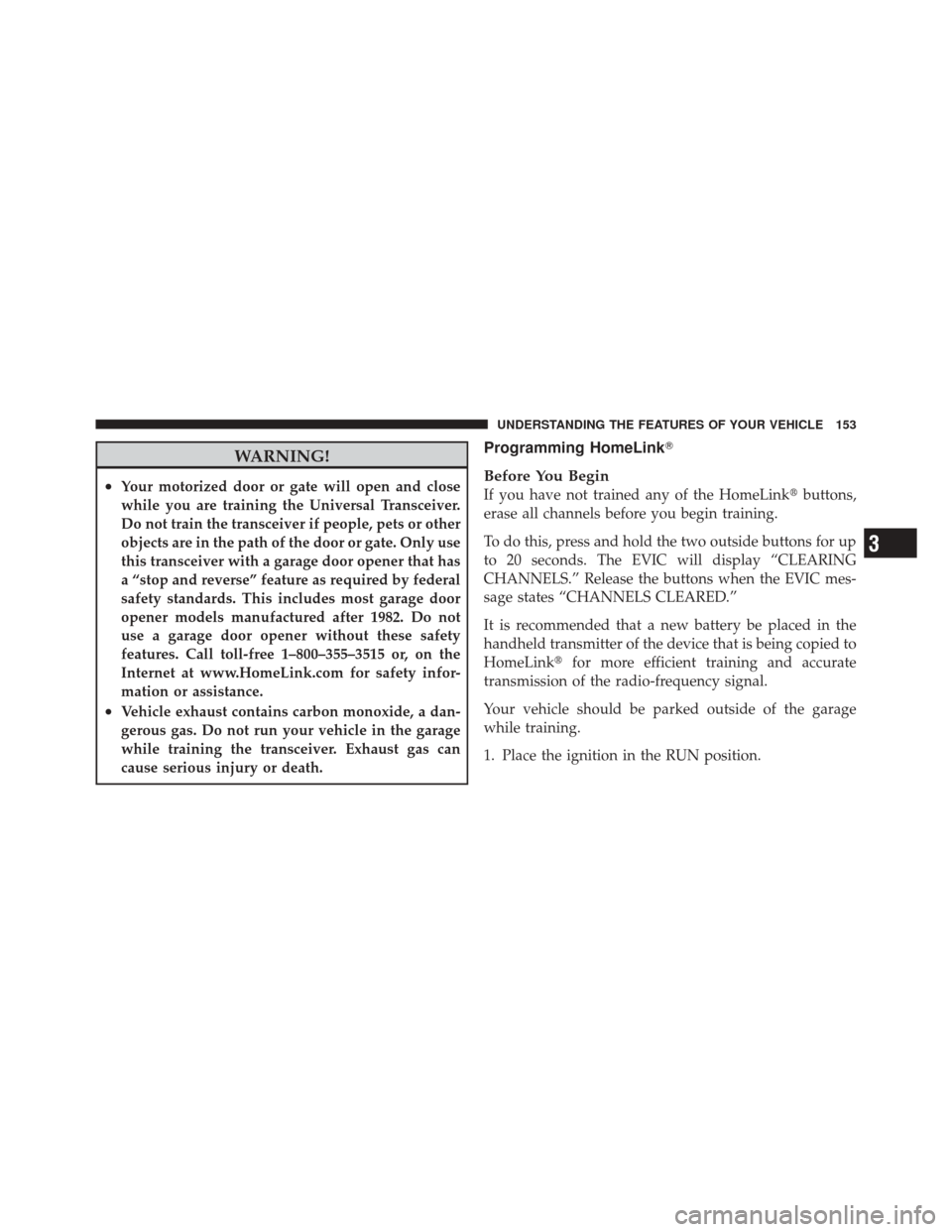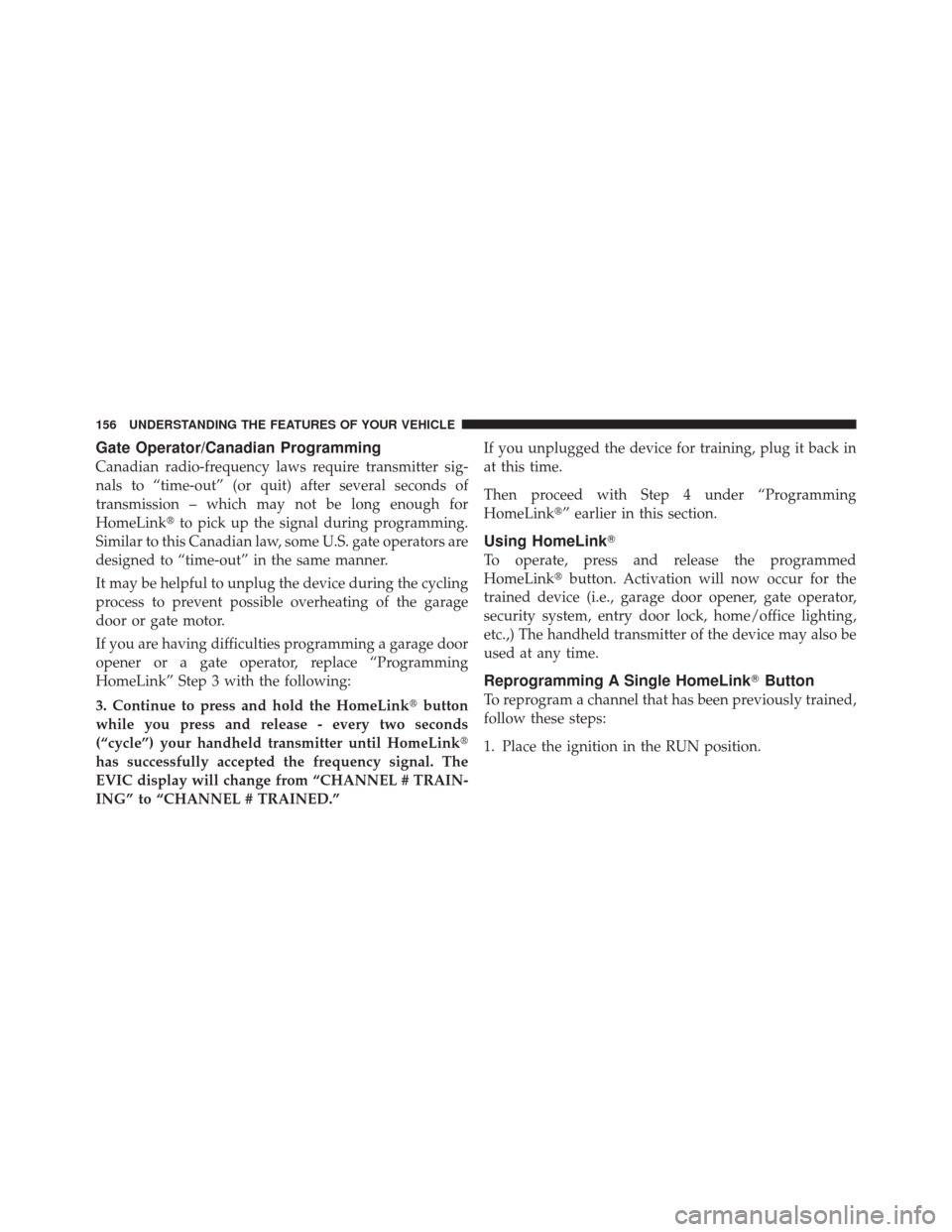Page 155 of 460

WARNING!
•Your motorized door or gate will open and close
while you are training the Universal Transceiver.
Do not train the transceiver if people, pets or other
objects are in the path of the door or gate. Only use
this transceiver with a garage door opener that has
a “stop and reverse” feature as required by federal
safety standards. This includes most garage door
opener models manufactured after 1982. Do not
use a garage door opener without these safety
features. Call toll-free 1–800–355–3515 or, on the
Internet at www.HomeLink.com for safety infor-
mation or assistance.
•Vehicle exhaust contains carbon monoxide, a dan-
gerous gas. Do not run your vehicle in the garage
while training the transceiver. Exhaust gas can
cause serious injury or death.
Programming HomeLink�
Before You Begin
If you have not trained any of the HomeLink �buttons,
erase all channels before you begin training.
To do this, press and hold the two outside buttons for up
to 20 seconds. The EVIC will display “CLEARING
CHANNELS.” Release the buttons when the EVIC mes-
sage states “CHANNELS CLEARED.”
It is recommended that a new battery be placed in the
handheld transmitter of the device that is being copied to
HomeLink� for more efficient training and accurate
transmission of the radio-frequency signal.
Your vehicle should be parked outside of the garage
while training.
1. Place the ignition in the RUN position.
3
UNDERSTANDING THE FEATURES OF YOUR VEHICLE 153
Page 158 of 460

Gate Operator/Canadian Programming
Canadian radio-frequency laws require transmitter sig-
nals to “time-out” (or quit) after several seconds of
transmission – which may not be long enough for
HomeLink�to pick up the signal during programming.
Similar to this Canadian law, some U.S. gate operators are
designed to “time-out” in the same manner.
It may be helpful to unplug the device during the cycling
process to prevent possible overheating of the garage
door or gate motor.
If you are having difficulties programming a garage door
opener or a gate operator, replace “Programming
HomeLink” Step 3 with the following:
3. Continue to press and hold the HomeLink� button
while you press and release - every two seconds
(“cycle”) your handheld transmitter until HomeLink �
has successfully accepted the frequency signal. The
EVIC display will change from “CHANNEL # TRAIN-
ING” to “CHANNEL # TRAINED.” If you unplugged the device for training, plug it back in
at this time.
Then proceed with Step 4 under “Programming
HomeLink�” earlier in this section.
Using HomeLink�
To operate, press and release the programmed
HomeLink�
button. Activation will now occur for the
trained device (i.e., garage door opener, gate operator,
security system, entry door lock, home/office lighting,
etc.,) The handheld transmitter of the device may also be
used at any time.
Reprogramming A Single HomeLink �Button
To reprogram a channel that has been previously trained,
follow these steps:
1. Place the ignition in the RUN position.
156 UNDERSTANDING THE FEATURES OF YOUR VEHICLE
Page 172 of 460

�Media Center 730N/430/430N (RHR/RER/
RBZ/RHB) CD/DVD/HDD/NAV —
If Equipped .......................... 201
▫ Operating Instructions (Voice Command
System) — If Equipped ................ 201
▫ Operating Instructions
(Uconnect™ Phone) — If Equipped ....... 201
� Media Center 130 (Sales Code RES) ......... 202
▫ Operating Instructions — Radio Mode ..... 202
▫ Operation Instructions —
CD Mode For CD And MP3 Audio Play .... 205
▫ Notes On Playing MP3 Files ............ 207
▫ Operation Instructions - Auxiliary Mode .... 210�
Media Center 130 With Satellite Radio
(Sales Code RES+RSC) ................... 210
▫ Operating Instructions — Radio Mode ..... 211
▫ Operation Instructions — CD Mode For CD
And MP3 Audio Play ................. 216
▫ Notes On Playing MP3 Files ............ 218
▫ List Button (CD Mode For MP3 Play) ...... 221
▫ Info Button (CD Mode For MP3 Play) ...... 221
▫ Uconnect™ Multimedia (Satellite Radio) —
If Equipped ........................ 222
� iPod�/USB/MP3 Control — If Equipped ..... 226
▫ Connecting The iPod� Or External USB
Device ............................ 227
▫ Using This Feature ................... 227
170 UNDERSTANDING YOUR INSTRUMENT PANEL
Page 173 of 460
▫Controlling The iPod� Or External USB
Device Using Radio Buttons ............. 228
▫ Play Mode ......................... 228
▫ List Or Browse Mode ................. 230
▫ Bluetooth Streaming Audio (BTSA) ........ 232
� Kicker� High Performance Sound System With
Driver-Selectable Surround (DSS) –
If Equipped .......................... 233
� Steering Wheel Audio Controls —
If Equipped .......................... 234
▫ Radio Operation ..................... 235 ▫
CD Player ......................... 235
� CD/DVD Disc Maintenance .............. 236
� Radio Operation And Mobile Phones ....... 236
� Climate Controls ...................... 237
▫ Automatic Temperature Control (ATC) ..... 237
▫ Automatic Operation .................. 237
▫ Blower Control ...................... 238
▫ Manual Operation .................... 238
▫ Operating Tips ...................... 242
4
UNDERSTANDING YOUR INSTRUMENT PANEL 171
Page 174 of 460
INSTRUMENT PANEL FEATURES
1 — Air Outlets5 — Heated Seat Switch9 — Ignition Switch
2 — Instrument Cluster 6 — ESP OFF Switch10 — Trunk Release Button
3 — Glove Compartment 7 — Hazard Warning Switch11 — Headlight Switch
4 — Radio 8 — Climate Control
172 UNDERSTANDING YOUR INSTRUMENT PANEL
Page 176 of 460

INSTRUMENT CLUSTER DESCRIPTIONS
1. Fuel Gauge
The pointer shows the level of fuel in the fuel tank when
the ignition switch is in the ON/RUN position.
2. Trip Odometer Button
Press this button to change the display from odometer to
either of two trip odometer settings. The letter “A” or “B”
will appear when in the trip odometer mode. Push in and
hold the button for two seconds to reset the trip odometer
to 0 miles (km). The odometer must be in TRIP mode to
reset it.
3. Speedometer
Indicates vehicle speed.
4. Electronic Speed Control Indicator LightThis light will turn on when the electronic
speed control is on. 5. Tachometer
The red segments indicate the maximum permissible
engine revolutions per minute (RPM x 1000) for each gear
range. Ease up on the accelerator before reaching the red
area.
6. Charging System Warning Light
This light shows the status of the electrical charg-
ing system. The light should turn on when the
ignition switch is first placed in ON/RUN and remain on
briefly as a bulb check. If the light stays on or turns on
while driving, turn off some of the vehicle’s non-essential
electrical devices (i.e., radio) or slightly increase engine
speed (if at idle). If the light remains on, it means that the
charging system is experiencing a problem. See your
local authorized dealer to obtain service immediately.
If jump starting is required, refer to “Jump Starting
Procedures” in “What To Do In Emergencies”.
174 UNDERSTANDING YOUR INSTRUMENT PANEL
Page 197 of 460

Refer to “Keyless Enter-N-Go” in “Starting And Operat-
ing” for more information.
NOTE:Under certain conditions, the display may be
superseded by another display of higher priority. But
when the ignition switch position is changed, the display
always re-appears.
Driver-Selectable Surround Sound (DSS) –
If Equipped
Press and release the MENU button until “Surround
Sound” displays in the EVIC, then press and release the
SELECT button. The EVIC provides information on the
current surround mode.
•Stereo
•Video Surround
•Audio Surround While in the Surround Sound menu, press the SELECT
button to change surround modes. The Video Surround
Mode will only be available for video media sources
(DVDs, Video CDs, or other video media supported by
the radio).
Compass Display
The compass readings indicate the direction
the vehicle is facing. Press and release the
MENU button until “Compass” displays in the
EVIC, then press and release the SELECT but-
ton. Press SELECT to display one of eight
compass readings and the outside temperature.
NOTE: The system will display the last known outside
temperature when starting the vehicle and may need to
be driven several minutes before the updated tempera-
ture is displayed. Engine temperature can also affect the
displayed temperature; therefore, temperature readings
are not updated when the vehicle is not moving.
MENU
Button
4
UNDERSTANDING YOUR INSTRUMENT PANEL 195
Page 202 of 460

NOTE:Turning the headlights on during the daytime
causes the instrument panel lights to dim. To increase the
brightness, refer to “Lights” in “Understanding The
Features Of Your Vehicle.”
Delay Turning Headlights Off
When this feature is selected, the driver can choose to
have the headlights remain on for 0, 30, 60, or 90 seconds
when exiting the vehicle. To make your selection, press
and release the SELECT button until “0,” “30,” “60,” or
“90” appears.
Hill Start Assist (HSA) — If Equipped
When on is selected, the HSA system is active. Refer to
“Electronic Brake Control System” in “Starting And
Operating” for system function and operating informa-
tion. To make your selection, press and release the
SELECT button until “ON” or “OFF” appears.
Turn Headlights On with Remote Key Unlock
When this feature is selected, the headlights will activate
and remain on for up to 90 seconds when the doors are
unlocked with the RKE transmitter. To make your selec-
tion, press and release the SELECT button until “OFF,”
“30 sec.,” “60 sec.,” or “90 sec.” appears.
Delay Power Off to Accessories Until Exit
When this feature is selected, the power window
switches, radio, Uconnect™ phone (if equipped), power
sunroof (if equipped), and ignition-powered power out-
lets will remain active for up to 60 minutes after the
ignition switch is turned OFF. Opening either front
vehicle door will cancel this feature. To make your
selection, press and release the SELECT button until
“Off,” “45 sec.,” “5 min.,” “10 min.,” “30 min.,” or “60
min.” appears.
200 UNDERSTANDING YOUR INSTRUMENT PANEL